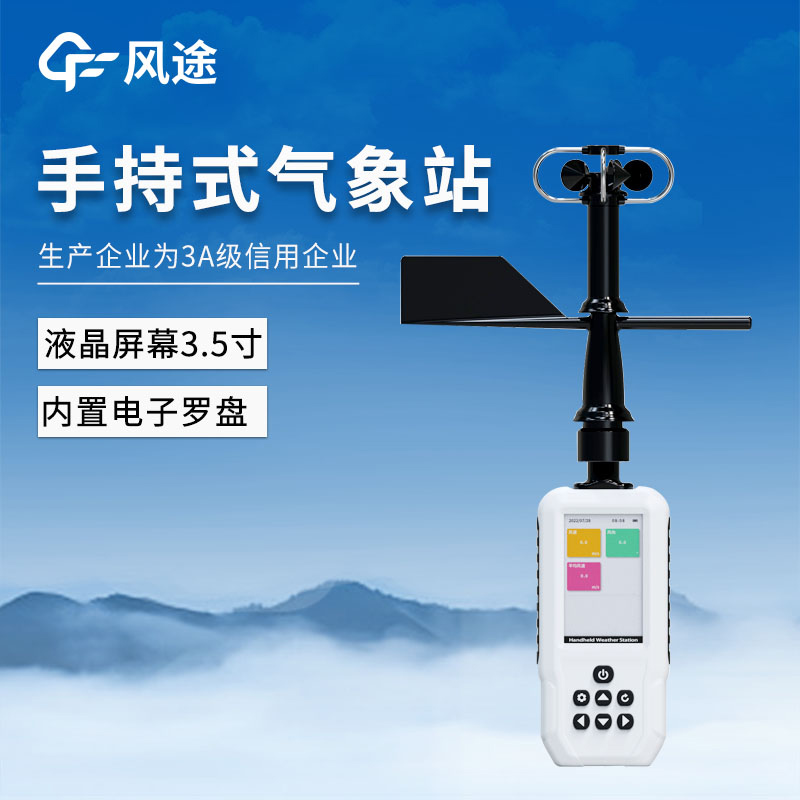Shandong Fengtu IOT Technology Co., Ltd
Sales Manager:Ms. Emily Wang
Cel,Whatsapp,Wechat:+86 15898932201
Email:info@fengtutec.com
Add:No. 155 Optoelectronic Industry Accelerator, Gaoxin District, Weifang, Shandong, China

Sales Manager:Ms. Emily Wang
Cel,Whatsapp,Wechat:+86 15898932201
Email:info@fengtutec.com
Add:No. 155 Optoelectronic Industry Accelerator, Gaoxin District, Weifang, Shandong, China
time:2025-06-03 09:56:54 source:Weather Station viewed:213 time
Handheld Weather Stations need continuous upgrades to better meet diverse meteorological monitoring needs. The FT-SQ6+ has been upgraded in multiple aspects compared to its predecessor, the FT-SQ5.
First, it offers a richer set of measurement parameters. The FT-SQ6+ adds measurements of average wind speed, heat index, wet-bulb temperature, wave height, etc., and is equipped with GNSS triple-mode positioning functionality. This allows it to provide not only meteorological information but also accurately acquire location data, opening up possibilities for more application scenarios.
In terms of storage capacity, the FT-SQ6+ has stronger data storage capabilities, capable of storing at least one year of meteorological data (up to 40,000 records), with flexible settings for data recording intervals. This provides robust data support for long-term meteorological monitoring. It also features an external DTU-4G module, allowing users to plug and replace IoT SIM cards at any time to upload data to cloud platforms via 4G, facilitating remote monitoring and data sharing, and greatly improving data availability and accessibility.
The FT-SQ6+ is equipped with a 3.5-inch LCD screen that can display more information, including wind speed, wind direction, average wind speed, temperature, humidity, atmospheric pressure, altitude, heat index, wet-bulb temperature, wave height, and GNSS triple-mode positioning data. This enables users to intuitively and comprehensively understand meteorological information. It also includes a built-in electronic compass for 360° wind direction monitoring, with the ability to switch between automatic and manual wind direction reading, making operations more flexible and convenient.
Powered by a 3,800mAh lithium battery and featuring low-power design, the FT-SQ6+ offers long standby time and can operate for 18 hours. Its battery life meets daily usage requirements while reducing the hassle of frequent charging.
In other aspects, the FT-SQ6+ has improved structural design, with optimized overall size and weight for enhanced portability. It also supports optional tripod mounting, expanding its usage scenarios. Its applications have become more versatile, catering to professional meteorological research, marine monitoring, outdoor exploration, agricultural planting, and other fields, providing users in different sectors with more accurate and comprehensive meteorological data support.
In summary, as an upgraded Handheld Weather Station, the FT-SQ6+ has achieved significant improvements and optimizations over its predecessor in measurement parameters, performance, data processing, operational experience, battery life, and application scenarios.

High-altitude weather observation lamp is a specialized device that utilizes light, electricity, and numerical control technology to monitor high-altitude migratory pests such as the fall armyworm. This device automatically performs tasks such as insect attraction, killing, and insect body processing. It is suitable for dynamic pest monitoring in locations such as rooftops and elevated platforms, and is particularly effective at night, providing effective technical support for agricultural pest management....
The FT-WQX10B is an all-in-one anion sensor that integrates the monitoring of a wide range of meteorological elements, including anion, PM2.5, PM10, temperature, humidity, barometric pressure, oxygen content, noise, wind speed and wind direction. The highly integrated design of this sensor makes ins...
In meteorological monitoring, accurate rainfall data is an important basis for the accuracy of weather forecasts. Traditional mechanical rain gauges have problems such as slow response, easy wear, and frequent maintenance, making it difficult to meet the needs of real-time and accurate rainfall moni...
In today's era, there is an increasing focus on the precise monitoring of local microclimates. Whether it is the control of the growth environment of crops in agricultural production, the consideration of regional climate comfort in urban planning, or the exploration of the relationship between...